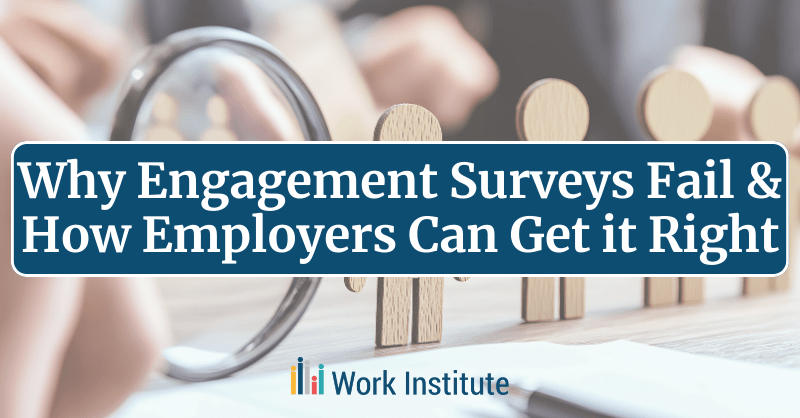The Engagement Survey Industry is Broken
Engagement surveys have grown into a billion-dollar industry. Nearly every employer uses them, yet disengagement and dissatisfaction remain historically high. Employers measure the problem (or so they think) but they never solve it. Leaders are often lulled into a false sense of security by positive survey scores while real issues continue to cause lower discretionary effort or turnover.
If traditional engagement surveys really worked, we wouldn’t still be facing widespread disengagement. The truth is that most surveys were never designed to predict or improve engagement. They were designed to ask if employees are engaged. That’s why it’s time to look at why they fail and what organizations should do differently.
How Did Engagement Surveys Get Here?
Engagement surveys were originally created to measure how employees feel about their work. They focused on sentiment, not the workplace conditions that shape engagement. Over time, vendors marketed them as a solution to workforce challenges they were never designed to solve.
Now, “engagement” is reduced to a number for leaders to compare against benchmarks. But a score alone doesn’t create accountability, reveal root causes, or show employers how to make meaningful improvements.
Why Most Engagement Surveys Fail to Create Engagement
- Overreliance on Favorability Ratings
- Traditional surveys lean heavily on favorability scores that may look good on paper but lack predictive and actionable value. High marks don’t necessarily mean employees will stay or that conditions are healthy.
- Asking the Wrong Questions
- Instead of uncovering what drives engagement, many surveys simply ask whether employees feel engaged. The result is shallow data with little actionability.
- Lack of Communicating Results
- Too often, survey results are collected and never shared with employees. This erodes trust and signals to employees that their voices don’t matter.
- Failure to Act on Feedback
- Collecting feedback without follow-up is worse than not asking at all. When leaders fail to implement changes, employees become skeptical, disengaged, and less likely to respond honestly, or at all, in the future.
- Benchmarks Over Root Causes
- Organizations compare themselves to external benchmarks instead of addressing their own internal drivers. This shifts the focus away from solving the real issues affecting their workforce.
The Cost of Getting It Wrong
The consequences are costly when engagement surveys fail to produce employee engagement.
- False Positives: Companies may celebrate “high engagement” while turnover and burnout remain high.
- Direct Turnover Costs: Every departure comes with recruiting, onboarding, and lost productivity costs.
- Hidden Costs: Disengagement drives absenteeism, presenteeism, lower productivity, and higher healthcare expenses.
- Compliance & Risk Exposure: Ignoring underlying workplace issues can lead to regulatory and fiduciary risks.
- Broken Trust Cycle: When employees stop believing their feedback matters, surveys become meaningless.
Work Institute’s Perspective: Two Decades Plus of Listening
At Work Institute, we’ve been studying employee engagement and retention since 2000. Through our Annual Retention Reports and more than 600,000 employee interviews, we’ve documented the real reasons people leave their jobs and what gets in the way of engagement.
Over the years, we’ve seen countless surveys and software tools promise to “fix” engagement, only to fail organizations and frustrate employees. For too long, we’ve watched employers rely on metrics that don’t predict retention and solutions that don’t create change.
We’ve sat by as these issues have plagued organizations and decided it was time to act. That’s why we developed the Employer Engagement Assessment: to help companies think differently, measure what truly matters, and finally make engagement actionable.
Why a New Approach is Necessary
Engagement isn’t a fixed score, it’s a condition employers create when they understand and act on what employees need. A new approach must:
- Measure conditions, not just sentiment.
- Deliver statistically reliable insights.
- Uncover both strengths and weaknesses.
- Provide actionable recommendations for leaders.
- Drive accountability and visible follow-up.
Our Employer Engagement Assessment Solution
That’s why Work Institute created the Employer Engagement Assessment. Built on insights from over 600,000 employee interviews and validated by independent psychometric experts, this survey is designed to help organizations move beyond metrics and into meaningful change.
- Targets the four drivers of engagement: Organization, Manager, Team, and Job.
- Replaces vague scores with the Net Excellent Score (NES) to elevate expectations.
- Uncovers workplace strengths and weaknesses with statistically reliable insights.
- Turns insight into action with dashboards, analytics, and consultant-led planning.
Traditional engagement surveys fail because they measure the wrong things and stop short of action. The result is broken trust, wasted resources, and continued turnover.
The Employer Engagement Assessment offers a better way. Our Assessment tool measures what truly matters, creates accountability for leaders, and empowers organizations to act with intent.
Join us on October 22nd for a live webinar where we’ll dive into why engagement surveys fail and how the Employer Engagement Assessment helps employers create workplaces where people thrive. Register for the Why Engagement Surveys Fail & How Employers Can Finally Get it Right webcast here.


